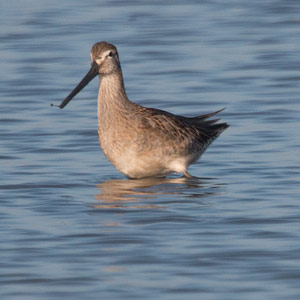Pratique | Identification
Observation et identification d’un Bécassin à long bec en Charente-Maritime en octobre 2018

Bécassin à long bec (Limnodromus scolopaceus) de première année, La Tanne Ronde, réserve naturelle de Moëze-Oléron (Charente-Maritime), le 20/10/2018.Photographie : Dominique Robin
Introduction
Octobre est l’un des meilleurs mois pour visiter les réserves naturelles du littoral atlantique français, comme celle des marais de Moëze-Oléron en Charente-Maritime : des milliers de limicoles y font une halte plus ou moins prolongée durant leur migration postnuptiale, et parmi les espèces régulières de barges, de bécasseaux et de chevaliers, des échassiers nord-américains accidentels y sont parfois découverts. Le 20 octobre 2018, Dominique Robin a ainsi signalé l’observation d’un Bécassin (anciennement Limnodrome) à long bec (Limnodromus scolopaceus). D’après la teinte chamois de ses parties inférieures, il s’agissait d’un oiseau de première année.
Après une présentation générale du genre Limnodromus, nous énumérons les critères ayant permis de distinguer l’oiseau de Charente-Maritime d’un Bécassin à bec court (Limnodromus griseus) du même âge, une espèce encore plus rare et au plumage et à la structure très proches, et nous vous proposons un tableau synthétisant les éléments pouvant être utilisés pour distinguer ces deux limicoles.
Abstract
October is one of the best months of the year to visit the nature reserves of the French Atlantic coast, such as the natural reserve of the marshes of Moëze-Oléron in the Charente-Maritime department: thousands of waders visit it during their postbreeding migration, and among the regular species of godwits, sandpipers and shanks, accidental North American species are sometimes found. The 20th of October 2018, Dominique Robin reported the sighting a Long-billed Dowitcher (Limnodromus scolopaceus) among Redshanks (Tringa totanus). According to the buff hue of its lower parts, it was a first-year bird.
After a general presentation of the Limnodromus genus, we enumerate the criteria used to distinguish this bird from a Short-billed Dowitcher (Limnodromus griseus) of the same age, an even rarer species with a very similar plumage and structure, and we propose a table summarizing of the identification tips of these two waders.
Poursuivez la lecture de cet article, en vous abonnant dès maintenant !
Découvrez les Archives d’Ornithomedia.com
Pour seulement 10,00 €TTC/an (ou 6,00 € les 6 mois)
Profitez de plusieurs centaines d’articles en accès illimité et sans aucun engagement.
Compléments
À lire aussi sur Ornithomedia.com
- Identifier les limicoles communs en Europe : première partie
- Un Bécassin à long bec couvant des os de mammifère
- La mue chez les oiseaux
- Observer les oiseaux dans la réserve naturelle de Moëze-Oléron
- Découvrir les oiseaux de l’île d’Oléron (Charente-Maritime)
Dans la rubrique Observations d’Ornithomedia.com
Bécassin à long bec (Limnodromus scolopaceus)
Dans la galerie d’Ornithomedia.com
Bécassin à long bec (Limnodromus scolopaceus)
À visiter sur le web
Le site web collaboratif www.faune-charente-maritime.org
Ouvrages recommandés
- Le guide Ornitho de Killian Mullarney
- Guide des limicoles d’Europe, d’Asie et d’Amérique du Nord (Broché) de Stephen Message, Don Taylo
Sources
- Alain Gentric (2010). Hivernage complet d’un Bécassin à long bec (Limnodromus scolopaceus) à La Turballe (Loire-Atantique) Bretagne Vivante. Ar Vran. Volume : 21. Numéro 2. http://pmb.bretagne-vivante.org:8090/pmb/uploads/AR_VRAN_2010_gentric_21-2.pdf
- Cin TyLee et Andresw Birch (2006). Advances in the Field Identification of North American Dowitchers. Birding. Septembre/octobre. https://pdfs.semanticscholar.org
- Mark Ameels (2004). Notes concernant l’identification du Bécassin à long bec (Limnodromus scolopaceus) hivernant en Zélande en 2003-2004. Aves. Volume : 41. Numéros 1-2. Pages : 107-119. www.aves.be/fileadmin/Aves/Bulletins/Articles/41_1-2/41_1-2_107.pdf
- R. J. Chandler (1998). Dowitcher identification and ageing: a photographic review. British Birds. Numéro : 91. Pages : 93-106. www.britishbirds.co.uk




Aucun commentaire sur ce sujet
Participer à la discussion !